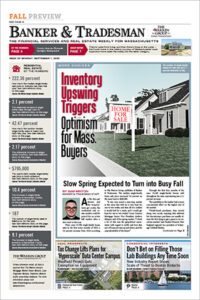With above-trend employment and wage growth, Boston’s economy should be the envy of the country, but federal immigration policy and cuts to scientific and medical research, among other things, could threaten the Bay State’s economy.
Those were some of the major themes to emerge from an economic outlook breakfast hosted Wednesday morning by Santander and the Greater Boston Chamber of Commerce.
First, the good: Massachusetts has an unemployment rate of about 3.2 percent, far below the national rate of 4.7 percent. On the whole, Massachusetts is more educated, and education generally predicts for better employment opportunities, particularly in sectors like education, health care and life sciences, which dominate here. Construction jobs have also come back, driven in part by demand for multifamily and apartment housing. David L’Heureux, Santander’s market manager for New England commercial banking, and Dr. Mary Burke, a senior research economist at the Federal Reserve Bank, ran down these highlights.
But the Bay State faces challenges, too. Housing is expensive and there’s not much stock for middle-income earners coming onto the market. Greater area also has the highest income inequality in the nation. And while education and health services may as well never have had a recession, manufacturing jobs slid fast during the Great Recession and have never recovered.
That hollowing out of middle-skill jobs is a critical piece of the wealth gap here in Boston, and it should underscore the importance of improving educational opportunities in the state, Burke said. Many of the jobs that have come back since the recession have largely been in high-earning, high-skilled jobs and low-skilled service jobs, without much growth in middle-income jobs for people with less formal education.
Turning to education, though Boston remains a top college city, enrollment is getting increasingly tough for those schools that aren’t internationally known names, Helen Drinan, president of Simmons College, said during a panel discussion. She predicted “significant consolidation” in education in the United States over the years to come and also acknowledged that the cost of education is becoming “untenable.” A handful of colleges, including Simmons, have piloted a program that graduates students from a bachelor’s and a master’s degree in four years, she said. The challenge is selling it to 18-year-olds.
And though housing is being built for both ends of the market, “nobody is really focusing on policies that address middle-income housing,” said Robert Korff, principal at Mark Development and one of Wednesday’s panelists.
As if the Bay State didn’t have enough of its own internal challenges, the new president’s agenda could also pose significant challenges. Anti-immigrant policies and posturing, for example, could tighten up an already very tight labor market. After all, without international migration, Burke said, Massachusetts would actually be losing population.
And Travis McCready, president and CEO of the Massachusetts Life Sciences Center, said on the panel that the life sciences field relies heavily on international migration to fill out jobs in the field.
Then there’s the president’s proposal to cut 20 percent of funding from the National Institutes of Health. Gov. Charlie Baker has estimated that would be a $500 million hit to the state of Massachusetts, and as McCready noted, those funds are not likely to be made up by private funding elsewhere.
“This has a potential direct impact not only to the economy here in Boston … but all the way out to Central Massachusetts and even Western Massachusetts,” McCready said, noting the myriad small businesses spun off by entrepreneurs in the life science space scattered across the state. “Boston will be able to bear the brunt, but some of those smaller communities won’t.”
McCready was blunt in his assessment: “If these cuts go forward, it will hurt our businesses.”






